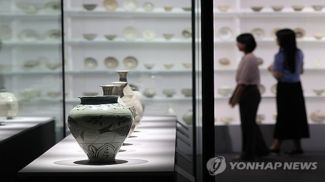JIANGSU, 2 December (BelTA - China Daily). - Lovingly preserved 'treasure' from universities' collections draws huge interest, Wang Kaihao reports.
About 1,300 years ago, a group of Buddhist monks or pilgrims copied a roll of sutra by hand and, in so doing, carried out an act of utmost homage to the deities. Despite the passing of time, the color has not faded, and therein lies a story of supreme human devotion. It was written in their blood, though the manner of its extraction is still not confirmed. It may have been the result of biting their own fingers to provide the "ink". More than a millennium has passed but, because of the addition of mineral dyestuffs mixed in with the blood, the color on the 3-meter-long scroll has not diminished.
This manuscript, Dafangbianfo Bao'en Jing ("sutra on the greatness of Buddha's repayment of kindness"), or simply known as "the gratitude sutra", was rediscovered in 1900 in one of the Mogao Caves at Dunhuang, Gansu province. About 60,000 volumes of ancient documents were found in that Buddhist grotto, commonly called "the library cave".
Successively owned by several collectors but now part of the collection of Nanjing University, the "gratitude sutra "makes a rare public appearance at an exhibition of ancient books at the university's art museum in the capital of Jiangsu province.
Over 200 copies of ancient manuscripts and books from the university's collection are showcased for the monthlong exhibition, Varied Splendor of Literary Troves: Selected Treasures From Nanjing University, which will run until Dec 21.
"We've been categorizing our inventory of ancient books for years," says Shi Mei, deputy director of Nanjing University Library and chief curator of the exhibition.
"And this is an opportunity to show how our traditional culture has been inherited through their pages," she adds. "Therefore, the very best from our collection is being presented."
According to Shi, it is the largest-scale exhibition of ancient books ever held by the university, and also one of the largest among Chinese universities.
Ancient Chinese books are defined as those predating 1911, the end of the monarchy in China.
Since 2014, the National Center for Preservation and Conservation of Ancient Books, which is based in the National Library of China in Beijing, has sponsored and helped to organize a series of exhibitions around the country under the banner Varied Splendor of Literary Troves, as translated from Cefu Qianhua, its original Chinese title.
The ongoing event at Nanjing University, or NJU, is the 30th exhibition in the series. It is only the second university involved in the program, the other being Zhejiang University, as most of the rest were presented by provincial- or city-level public libraries.
It is probably not exaggerating to call many of the exhibits "national treasures".
Another highlighted exhibit is a set of four printed books compiled by iconic Confucian philosopher Lyu Zuqian from the Song Dynasty (960-1279), which are annotations on the history of the Southern Dynasty (420-589). It is the oldest printed work in the university's collection and is also an example of early-stage Chinese print technology.
The books were designed to be portable to better disseminate the historical documents among readers. The pages were soaked in pepper water as a preservative, so they have never been eaten or damaged by bugs and remain in pristine condition.
Surviving copies of Yingwuzhou ("a parrot island"), a printed opera script from 1616, were only housed in Nanjing University and the National Library of China. And this exhibited edition is famed for its value, not only in literature, but also in art. The book contains a series of exquisite illustrations, and some of them are not seen in the copy on display at the national library.
Additionally, a tattered page from Yunji Qiqian ("the seven slips in a book bag"), a milestone anthology of Taoist canons, at the exhibition will also raise the excitement level of ancient book collectors.
Shi explains that the anthology was first published in the 11th century, in which many previously lost Taoist canons were retrieved. An emperor of the Jin Dynasty (1115-1234) once ordered a reprint of this 120-volume tome, but almost all the copies were soon destroyed during a war that broke out shortly afterward.
"Only its scattered pages can be seen," Shi says. "So this page is extremely precious."
At the exhibition, a visiting collector half-jokingly asked Shi whether this is for sale.
"No matter how high a price you offer, it's out of the question," Shi responded. "We collect it and we have the duty to take good care of it while it is in our custody."
The cultural legacy
Custodians of these precious pages understand the painstaking efforts by their predecessors to pass these collections down to future generations, sometimes against incredible odds.
According to Cheng Zhangcan, director of Nanjing University Library, about 400,000 ancient books were housed in the university, and about 30,000 copies are listed as "rare and precious editions".
"The collection is comprehensive," Cheng says. "Our special collections feature local chronicles, atlases of frontier areas, and serial books during the Ming (1368-1644) and Qing (1644-1911) dynasties."
Nevertheless, many of them have stayed in the warehouse and remained unknown to the public, let alone their individual odysseys through wars and the social upheaval of the last century.
Apart from donations from scholars and alumni in recent decades, most ancient books in the collection come from the then National Central University, predecessor of today's NJU, and University of Nanking, a private university that was merged into the NJU in 1952.
John Calvin Ferguson (1866-1945), an American Sinologist who was president of the University of Nanking, also made a key contribution to enrich the inventory. In 1934, he donated his entire collection of Chinese books and cultural relics to the university, including "the gratitude sutra" and Yunji Qiqian that are on display.
In 1937, when the War of Resistance Against Japanese Aggression (1931-45) approached Nanjing, the Chinese capital at the time, the Central University was relocated westward to Chongqing in case it fell into enemy hands.
Some other private universities in China chose to remain in situ, because their connection with Western countries could offer a temporary protection against the Japanese invaders, but the University of Nanking made a patriotic decision to move westward as well. It was relocated to Chengdu, Sichuan province.
The many ancient books belonging to both universities were also relocated. However, even that was not a simple process. Due to a lack of transportation, some books had to be hidden en route, at a doctor's house in Wuyuan county, of today's Jiangxi province, until the war ended, according to Shi.
"Fortunately, all of the books were later returned to Nanjing, safe and sound," Shi says. "When staying in Sichuan province during the tough wartime years, librarians still continued to collect ancient books and brought back an even greater number of precious documents.
"This cultural heritage made a great contribution to development of academic studies over the past century," she says.
A hoard of pages
The national census of ancient books, which is almost finished, has registered more than 2.7 million ancient volumes. The total number of copies were estimated to be more than 30 million.
According to Zhang Zhiqing, deputy director of the National Center for Preservation and Conservation of Ancient Books, about 20 percent of them are housed in universities, making them the second-largest collection category only after public libraries. In Peking University alone, for example, more than 1 million documents are housed.
In 2007, a national comprehensive project on conservation of ancient books was launched, which included the collections of the universities in the country's general blueprint for the first time.
Some major achievements have been made.
In Fudan University in Shanghai, for instance, a research academy focusing on the preservation of ancient Chinese books was established in 2015. This aims to help scholars not only of literature, history and ancient documentation, but also chemistry, biology and materials science, as well as other natural sciences. Many practitioners of intangible cultural heritage, like woodblock printing, are also hired by the academy to revive traditional craftsmanship.
"Unlike public libraries, where expertise is focused on humanities, universities have a wider range of expertise and will usher in new thinking with regard to the protection of ancient books," Zhang says.
Similar institutions were also set up in Sun Yat-sen University, in Guangzhou, Guangdong province, and Tianjin Normal University. In June, an academy specifically for preservation of ancient books of local non-Han ethnic groups was established in Guizhou Minzu University in Guiyang, Guizhou province.
Separately, in Nanjing, a national hub of the printing industry and bookstores during the Ming and Qing dynasties, another form of cooperation also demonstrates the city's extraordinary status in ancient cultural history. There is a cluster of custodians of ancient books, including the NJU, Nanjing Library, and various archives, as well as some vocational schools and an art academy in the city, which also train conservators of ancient books. Frequent communication among these institutions facilitates the study and preservation of the pages, as Shi points out.
Nevertheless, Zhang says the value of the huge collections of the universities can still be further demonstrated.
"A national-level alliance to specifically coordinate the study and preservation of ancient books in universities is still absent," Zhang says. "Most schools now rely on their own efforts."
Consequently, the first national conference of university libraries on ancient book protection was held at Nanjing University in 2019 to promote an exchange of experiences. The second edition of the conference was held at Zhejiang University in Hangzhou in July.
Another problem lingers: There is a lack of personnel in charge of the universities' collections of ancient books. For example, only two full-time restorers of ancient books work at Nanjing University Library.
Considering that about one quarter of the ancient books in the inventory awaits restoration, Shi says she needs more people for that position. However, for such a prestigious university, the academic requirement is demanding when introducing a new employee.
Training expertise through regular university syllabuses is one solution. In China, master's degrees related to ancient book restoration are bestowed in more than 10 universities, as Zhang points out. Nonetheless, no university has opened a department tailored to the field in undergraduate education.
"That means ancient books are not treated as an independent 'major' in college, and is only considered as a branch of fine art or publishing," Zhang says.
Based on successful trials of interdisciplinary research at Fudan University and other higher institutions, Zhang believes it is essential to set up a specific major focused on ancient books, thus forming a sustainable training system for the future.













